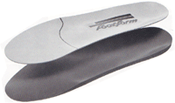April 16, 2008 11:45 AM
Hi Randall, I was wondering if you can tell what elements are needed for a generic insole that would bring comfort to a shoe wearer. What material would you use? By the way your blog is amazingly full of facts and I am enjoying reading each post. SADear SA,
In the shoe industry, the term generic insoles refers to what's also called a sock liner, contoured insole, or generic orthotic.
- Sock liners are generally a flat cushion layer, sometimes removable, but usually glued into the shoe.
- Contoured insoles are formed from molded foam to fit the shoes interior and cup the the mid-foot and heel around the edges. Generally this insole has little to no anatomy.
- Generic orthotics are formed from molded foam or/and other materials. It is like a contoured insole, but has actual arch contour and more anatomy.
- Sock Liners: Multi-density foam layers. One layer that forms to the foot layered over one resilient layer that springs back to the original shape.
- Contoured Insoles: The same as a multi-density sock liner, but with the upper layer being a molded foam shape.
- Generic orthotics: Typically an after-market product, sometimes they are actually built into a shoe such as a Birkenstock. The most important thing is that the contour doesn't offend the user's foot contour.
The optimal high performance is a custom orthotic. Because this option isn't available to everyone, the next best thing is to try on a multitude of generic orthotics to seek a good match.
Note: I offer consulting to manufacturers and designers seeking information about foot contours, orthotic shapes and materials. In the past I've patented two systems relating to this research.









No comments:
Post a Comment